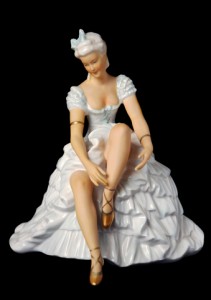 There are many many brands and varieties of pointe shoes in the marketplace today. Each pair is so markedly different – primarily because the fit of toe shoes has to be so exact, that it needs to fit your feet like a glove – not an easy thing to do when its made of hard materials like leather, plastic, cardstock, burlap and glue. As a dancer, our entire body weight is balanced on that small space created at the end of the pointe shoe – it has to be a very secure fit. And, because every dancer has unique feet, with variations that include toe length and shape, arch flexibility and mechanical strength – most pointe shoe manufacturers produce more than one model of shoe.
There are many many brands and varieties of pointe shoes in the marketplace today. Each pair is so markedly different – primarily because the fit of toe shoes has to be so exact, that it needs to fit your feet like a glove – not an easy thing to do when its made of hard materials like leather, plastic, cardstock, burlap and glue. As a dancer, our entire body weight is balanced on that small space created at the end of the pointe shoe – it has to be a very secure fit. And, because every dancer has unique feet, with variations that include toe length and shape, arch flexibility and mechanical strength – most pointe shoe manufacturers produce more than one model of shoe.
Ever wonder how modern-day pointe shoes developed into what they are today?
Here’s a brief history, courtesy of Wikipedia: When women began to dance in ballet in 1681, twenty years after King Louis XIV of France ordered the founding of the Académie Royale de Danse, the standard women’s ballet shoe had heels. Mid-18th century dancer Marie Camargo of the Paris Opéra Ballet was the first to wear a non-heeled shoe, enabling her to perform leaps that would have been difficult, if not impossible, in the more conventional shoes of the age. After the French Revolution, heels were completely eliminated from standard ballet shoes. These flat-bottomed predecessors of the modern pointe shoe were secured to the feet by ribbons and incorporated pleats under the toes to enable dancers to leap, execute turns, and fully extend their feet.
The first dancers to rise up on their toes did so with the help of an invention by Charles Didelot in 1795. His “flying machine” lifted dancers upward, allowing them to stand on their toes before leaving the ground. This lightness and ethereal quality was well received by audiences and, as a result, choreographers began to look for ways to incorporate more pointework into their pieces.
As dance progressed into the 19th century, the emphasis on technical skill increased, as did the desire to dance en pointe without the aid of wires. When Marie Taglioni first danced La Sylphide en pointe, her shoes were nothing more than modified satin slippers; the soles were made of leather and the sides and toes were darned to help the shoes hold their shapes. Because the shoes of this period offered no support, dancers would pad their toes for comfort and rely on the strength of their feet and ankles for support.
The next substantially different form of pointe shoe appeared in Italy in the late 19th century. Dancers like Pierina Legnani wore shoes with a sturdy, flat platform at the front end of the shoe, rather than the more sharply pointed toe of earlier models. These shoes also included a box—made of layers of fabric—for containing the toes, and a stiffer, stronger sole. They were constructed without nails and the soles were only stiffened at the toes, making them nearly silent.
The birth of the modern pointe shoe is often attributed to the early 20th century Russian ballerina, Anna Pavlova, who was one of the most famous and influential dancers of her time. Pavlova had particularly high, arched insteps, which left her vulnerable to injury when dancing en pointe. She also had slender, tapered feet, resulting in excessive pressure applied to her big toes. To compensate for this, she would insert toughened leather soles into her shoes for extra support and would flatten and harden the toe area to form a box. This made dancing en pointe easier for her, and although it was regarded by her peers as “cheating”… ironically, this practice became the predecessor of the modern pointe shoe we see today.